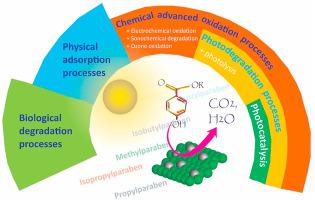Chemosphere ( IF 8.8 ) Pub Date : 2021-03-03 , DOI: 10.1016/j.chemosphere.2021.130163 Van-Huy Nguyen , Lan-Anh Phan Thi , P. Sri Chandana , Huu-Tuan Do , Thuy-Hanh Pham , Taeyoon Lee , Trinh Duy Nguyen , Cuong Le Phuoc , Pham Thi Huong

|
Parabens are a class of compounds primarily used as antimicrobial preservatives in pharmaceutical products, cosmetics, and foodstuff. Their widely used field leads to increasing concentrations detected in various environmental matrices like water, soil, and sludges, even detected in human tissue, blood, and milk. Treatment techniques, including chemical advanced oxidation, biological degradation, and physical adsorption processes, have been widely used to complete mineralization or to degrade parabens into less complicated byproducts. All kinds of processes were reviewed to give a completed picture of parabens removal. In light of these treatment techniques, advanced photocatalysis, which is emerging rapidly and widely as an economical, efficient, and environmentally-friendly technique, has received considerable attention. TiO2-based and non-TiO2-based photocatalysts play an essential role in parabens degradation. The effect of experimental parameters, such as the concentration of targeted parabens, concentration of photocatalyst, reaction time, and initial solution pH, even the presence of radical scavengers, are surveyed and compared from the literature. Some representative parabens such as methylparaben, propylparaben, and benzylparaben have been successfully studied the reaction pathways and their intermediates in their degradation process. As reported in the literature, the degradation of parabens involves the production of highly reactive species, mainly hydroxyl radicals. These reactive radicals would attack the paraben preservatives, break, and finally mineralize them into simpler inorganic and nontoxic molecules. Concluding perspectives on the challenges and opportunities for photocatalysis toward parabens remediation are also intensively highlighted.
中文翻译:

对羟基苯甲酸酯防腐剂的降解:光催化的最新进展和可持续方法
对羟基苯甲酸酯是一类化合物,主要用作药物,化妆品和食品中的抗菌防腐剂。它们广泛使用的领域导致在各种环境基质(如水,土壤和污泥)中甚至在人体组织,血液和牛奶中都检测到浓度升高。处理技术,包括化学高级氧化,生物降解和物理吸附过程,已被广泛用于完成矿化作用或将对羟基苯甲酸酯降解为较不复杂的副产物。审查了所有过程,以全面了解对羟基苯甲酸酯的去除情况。根据这些处理技术,作为一种经济,有效和环境友好的技术而迅速而广泛地出现的先进的光催化作用已经引起了广泛的关注。二氧化钛2基和非TiO 2基光催化剂在对羟基苯甲酸酯的降解中起重要作用。从文献中调查并比较了实验参数的影响,例如目标对羟基苯甲酸酯的浓度,光催化剂的浓度,反应时间和初始溶液的pH值,甚至自由基清除剂的存在。对羟基苯甲酸甲酯,对羟基苯甲酸丙酯和对羟基苯甲酸苄酯等一些代表性的对羟基苯甲酸酯已经成功地研究了其降解过程中的反应途径及其中间体。如文献报道,对羟基苯甲酸酯的降解涉及高反应性物质的产生,主要是羟基自由基。这些反应性自由基会攻击对羟基苯甲酸酯类防腐剂,使其破裂并最终矿化成更简单的无机和无毒分子。


























 京公网安备 11010802027423号
京公网安备 11010802027423号